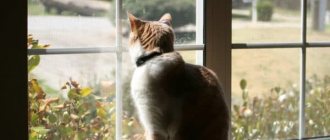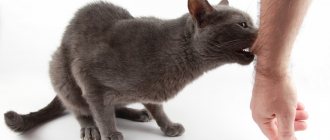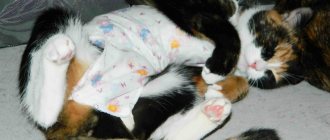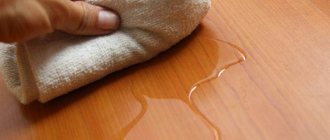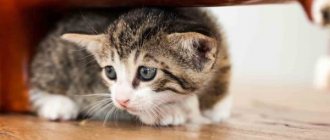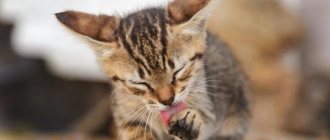Even many years of living with a pet cannot guarantee a complete understanding of its behavior. So many owners wonder why cats rub against their legs? This phenomenon often manifests itself in relationships between humans and animals. In addition, the pet may rub against other objects in the house and even outside it. Therefore, some owners need an explanation for this behavior of their pets.
The animal world differs significantly from the human world in terms of transmitting information. For these purposes, individuals often use odors. In particular, an excellent sense of smell gives cats the ability to quickly determine the position of the prey. This skill is one of the means of survival in the wild. Pets use their sense of smell to find a home or their own young.
© shutterstock
In an apartment, the pet still considers it necessary to limit the limits of its territory. This is the root cause of a cat rubbing against people or furniture, for example. There are special zones on the animal’s body that secrete a special secretion. Most of them are concentrated :
- on the muzzle;
- on the paws;
- around the anus.
It is especially noteworthy when a cat rubs its muzzle against its owner's face. After all, a huge amount of secretion is located in the forehead area. During such a ritual, the animal may purr and look extremely happy. This indicates that the process gives him satisfaction and brings peace. This reaction is associated with the original cause of this phenomenon: the cat feels safe in its territory.
By the way, this instinct is not only associated with creating boundaries. The fact is that cats live in families, and by smell they can determine whether they belong to a pride. Owners of two or more pets may notice that they are rubbing against the same object or corner. This is due to the fact that they belong to the same clan.
The meaning of smells in the cat world
Let’s immediately make a reservation that the cat rubs against the owner’s legs in order to mark him as property and inviolable property! Cats (and dogs too) have three “sources” of personal odor - secretions secreted by glands on the face, between the toes and on the surface of the anus. Another “ink” to mark the territory is urine, which has no “significant” odor without the secretion secreted by those same paranal glands.
Note! When a cat marks territory, it jerks its tail held high to stimulate the paranal glands.
Sometimes, odorous substances are called pheromones; this interpretation is a little incorrect, but sometimes it is appropriate. Some, especially territorial cats, not only rub against their owner, but also lick him. Particularly passionately, the pet eliminates the smell of sweat under the arms and on the legs. We can explain the not entirely hygienic process by the same desire to mark a person with one’s smell.
Note! "Wet deeds" found in shoes also indicate an attempt to leave a mark. It is incorrect to write on a person, but leaving your scent on shoes is quite appropriate. Males can mark hats and outerwear.
Increased anxiety in a child
The main reason
Anxiety in a child is the constant presence of the nervous system in a protective adaptive reaction to external situations and circumstances that the child for some reason assesses as dangerous (stress reaction). The child may not be aware of them, since he grows up in them from birth, and he is used to them, but subconsciously feels restless and unsafe.
Common symptoms of increased anxiety in a child:
- Anxiety in a child is often manifested by excessive attachment to the mother, since for the child she is the natural source of calm.
- Increased anxiety may be accompanied, or, conversely, by exhaustion of the nervous system, depression, etc. The brain cannot maintain anxiety and excitement indefinitely and quickly becomes exhausted.
- Very often, excessive anxiety is accompanied by immune depression (secondary immune deficiency due to stress) and frequent illnesses. For example, a child is highly susceptible to colds, brings all the infections that appear there from kindergarten, and spends a long time at home undergoing treatment.
- An almost obligatory and most common manifestation of increased anxiety is sleep disturbance; the child has trouble falling asleep and often wakes up. Or, at first glance, he sleeps enough and a lot, but does not get enough sleep and gets up in the morning in a bad mood.
- .
First of all, it is necessary to understand in which area the causes of the problem lie. In psychological or medical
.
- Increased anxiety as a psychological problem.
- Anxiety in a child due to medical problems. This could be long-term brain damage during childbirth, hypoxia, asphyxia or birth trauma, after which the brain itself begins to generate anxiety in response to external circumstances. This may be increased intracranial pressure; in more complex situations, the causes may be autistic disorders, childhood psychoses, or even schizophrenia. And in order to help a child as effectively as possible, you need to accurately determine the nature of anxiety.
The Inexplicable Behavior of Cats
The pet curled up into a ball and hid its face in its paws, you opened the closet and took out a warm sweater... after all, this is a sign, such behavior promises cold. You'd be surprised how many superstitions are associated with cats. For example, in ancient Rus', a cat was allowed into the baby’s cradle so that it could lie down and rub itself. Afterwards the child was put to bed, and he slept soundly.
A cat that rubbed itself against the guest’s legs suggested that the person came with good intentions and did not keep a stone in his bosom. Perhaps this is an exaggeration, but it’s not for nothing that they say that purrs see the energy of people, and they immediately smell cruel and vile bipeds... they scream, hiss and even attack them.
The ginger cat that rubs at your feet absorbs all the negative energy. Why exactly red is unknown. Most likely, this is due to another sign that sunny cats bring happiness, wealth and good luck to the owner. Again, the red cat brings peace to the family and eliminates conflicts, calming down the “separated” husband or wife.
Why it is not recommended to drive away a cat that rubs against your legs
Cats have been domesticated since time immemorial, so it is not surprising that over several millennia a lot of superstitions and signs have appeared associated with these cute creatures:
- a cat sneezing at a wedding promises happiness to the newlyweds;
- The pet's tail will help get rid of barley; just apply it to the sore spot;
- if a pet shits on a patient’s clothes, then you should rejoice - it means the person is on the mend;
- When a cat sees off people getting ready to go on a journey with a loud meow, it is worth putting off the journey.
There is also an opinion that it is impossible to drive a pet away from you - a person who offends this animal is seriously sinning and in the next world he will be met by angry cats, biting and scratching.
Cats and religion. Felines acted as guides to another world in various religions, including Christianity. They were considered divine creatures and were greatly revered. In the early stages of the formation of the world's largest religion, cats were depicted next to saints. Francis of Assisi, one of the most famous Catholic saints, was once saved by a cat. He caught a rat infected with the plague. Since that time, services dedicated to these animals began to be held in churches.
Perhaps, by trying to rub against your legs, the pet is showing care and affection in this way, which means that refusal can offend and upset your furry friend. Cats have a good memory; they remember betrayal and neglect for a long time.
Also watch the video why cats rub against people:
Possible negative consequences
Sometimes cats rub so hard that they drool. Some animals are so emotional that saliva literally drips from the mouth as soon as the pet sees the owner or experiences other pleasant stress. The consequences in the form of wet spots everywhere (on furniture, clothes) are not acceptable for everyone. With particular passion, pets slobber on the owner's underwear and other personal belongings. By the way, your phone, wallet, and talismans (which you constantly carry with you) are also “at gunpoint.”
You may not mind the inconvenience, but think about the cat. How worried is she that she manages to bring her body into hyperactive mode? How can you help your pet come to its senses? Firstly, do not rush to self-medicate and prescribe sedatives to your pet, and secondly, observe whether your purr experiences discomfort or depression after the act of “slobber rubbing”. Alarming symptoms are apathy, arrhythmia, shortness of breath, unsteady gait, weakness (the cat lies down helplessly and dozes).
You should start by using special fermions (sold in a pet store). The product is sprayed indoors or onto specific objects. Typically, the composition includes soothing substances and chemical compounds that emit the smell of a cat.
If your pet does not feel more confident, you should contact a veterinarian and, under his supervision, begin a course of sedatives and supportive medications. Stress is often associated with a hidden pathology, so we recommend that you undergo general blood and urine tests for your pet.
Is there any danger?
Domestic cats who adore their owner pose no danger when they mark their owner's feet or belongings. Owners should be concerned if the animal produces a lot of saliva upon contact and behaves lethargically. Your furry friend may be stressed. It is worth taking him to the veterinarian, who will prescribe the appropriate medications.
Stray cats can carry microorganisms on their fur that, when transmitted to humans, cause serious diseases such as rabies, toxoplasmosis and ringworm.
You should not once again allow a stray cat to rub against your legs, unless the person has a noble goal of taking him with him.
The kitten expresses love and seeks reciprocal affection
The desire of adult cats to place their scent marks everywhere is quite understandable, but why then do small kittens, who are clearly not yet mature enough to make territorial claims, also rub against their owner’s legs? Felinologists have an opinion on this matter as well.
When an animal rubs its muzzle against someone, it not only transfers its scent to the object, but also performs an important social ritual. In this way, for example, a mother cat communicates with her offspring. For them, the touching of their faces is a way to make sure each other is feeling well, express trust, communicate their readiness to care, and instill a sense of security.
If a kitten gets in the owner’s face or rubs against his neck, this means that the baby subconsciously associates the person caring for him with his mother and expresses love for him in the way he is used to. You need to pet the baby in return. Establishing contact at this level is a very good sign, indicating that a strong trusting relationship will be formed between the animal and its owner in the future.
What do scientists think about the similarities between an owner and his pet?
The fact that there is a similarity between a pet and its owner could not but interest the scientific world.
One day, Dr. Jeanie Graham Scott had a chance to visit a dog show and there she made a discovery for herself: how similar animals and their owners are to each other. This was so obvious and so surprising to the scientist that Dr. Scott wrote a book about it with illustrations made at that exhibition.
This is interesting: The unusual ritual “Dog Spinning”: what pets are guilty of
The author of the book is sure that time decides everything - how long the owner and his pet live side by side. They develop a general perception of the world and what is normal for a person becomes just as natural for a pet. Dr. Scott also added that the older dog resembles its owner more closely than he does with his own children.
What the experiment showed
Dr. Nicholas Chistenfield from San Diego came up with an interesting idea for an experiment. He took 45 photographs depicting couples - dogs and their owners. Then he separated the pairs using a computer, so that there were no clues about the connection between the frames.
The photographs were distributed to students and asked to create pairs from all those available: a dog and its owner. The students did not have any clues; they had to focus solely on external resemblance.
Among the dogs there were 25 purebreds, the remaining 20 were mestizos. Students guessed 65% of the pairs in which the dog was purebred. With mestizos the results were worse. When they began to look into it, it turned out that the unmatched pairs were those where the pet appeared by chance, that is, the dog was either given as a gift, or they had to take it into the house because there was no other way out.
Be that as it may, the fact that in the owner-animal relationship it happens that over the years they become so similar in appearance and character makes their coexistence more comfortable and allows for the formation of real emotional intimacy.
Opinion of zoopsychologists
Animal psychologists often express their assessment of this phenomenon. Most associate this ritual with the peculiarities of the relationship between a mother cat and her cub. Already at a more conscious age, the pet partly sees its parent in its owner. That's why he rubs against it, showing gratitude and care. But the young inhabitants of the streets are in this way trying to get a little affection and human attention.
Also, according to animal psychologists, the reason for this habit may lie in the behavioral characteristics of the animal. It is tactile contact that is most preferable for a cat in the process of expressing its own emotions and sensations. This means that when a pet rubs against a person’s legs, he wants to show his feelings. This theory is confirmed by the fact that many self-sufficient cats do not demonstrate such rituals at all.
By the way, the absence of this habit can also be indicative. It often indicates such things:
- lack of trust;
- temporary resentment;
- dissatisfaction with the conditions.
But performing the ritual 1-2 times a day clearly indicates that the cat is happy and does not need anything. Of course, there are also much more active individuals who rub often, clearly showing warm feelings towards the owner. Such pets show their love in other ways.
Animal psychologists also suggest that a cat rubs its legs when it wants to get more data about the world around it. This is especially noticeable when the animal finds itself in an unfamiliar environment. At this moment, you can clearly see how wariness develops into curiosity, and the cat gradually begins to rub against various objects and people present. In fact, the pet is trying to adapt to the new and calm itself. Various odors are especially disturbing for cats.
They mark territory
Cats have many scent glands on their faces. They are found around the mouth, on the chin, on the cheeks, on the neck and on the ears. When a cat rubs its face against an object, it leaves behind a scent - this is called butting. The height of the object determines how much of the head will be used. These animals also tend to choose conspicuous objects, such as a protruding corner, a wall, the edge of a coffee table or sofa, or even the corner of a book or box. Males tend to mark more things. They also tend to cover up odors left by their fellow creatures.
Read also: How to choose the right bar for your home
The cat rubs against its legs: should we wean it or encourage it?
If the pet is healthy and has a nice coat, then confusion underfoot should be treated favorably, except for the following cases:
- Begging . When your pet has received his allotted portion of food and asks for more, you should not follow his lead. It is necessary to distribute food distribution so that the cat eats less during the day and more in the evening. To ensure a good, healthy sleep at night. If the cat receives ready-made food, but begs for pieces of meat or fish when cutting it, it is better not to give it. It has been observed that when fed premium or higher prepared foods, cats get sick less and live longer.
- The sterilized cat began to rub herself. An unspayed female may have bred nearby. In order not to provoke sexual behavior, you need to leave.
- The pet is trying to pity the owner and allow him into the child’s bedroom or room, where he is not allowed to enter. What to do? Ignore. The cat will understand that his attempts are not being followed and will stop bothering him.
